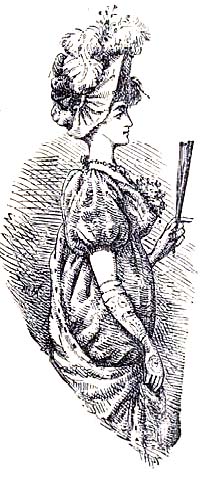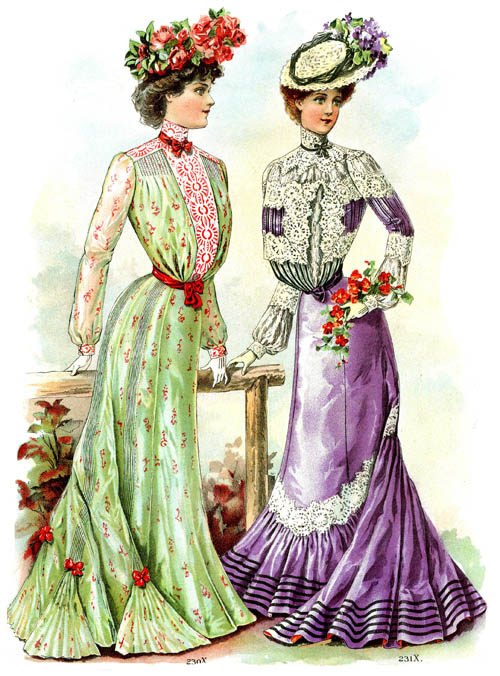|
Home > The Victorian Woman > Women's Issues > The Ideal Woman

|
What should a woman "be"? What is her role? What behaviors are acceptable, and which are not? When one lives in a world of changing roles, often what one desires most is some sort of definitive answer on who one "should" become and how to become that person. In the Victorian era, women's roles were changing - and while many women embraced that change, many others did not. Articles abounded in women's magazines expressing various opinions on what a woman should be and do - basically a running commentary on the ever-changing view of what constituted the "ideal" woman. While many of these articles express men's desires to keep women in the nice, comfortable supportive role they'd held for so many centuries, many women express the same thoughts and strive to admonish their wayward sisters who have strayed down that path of "women's rights." Here's a chronological look at changing notions of the "ideal" Victorian woman. |
- Women, Many and Various: The Belles and the Wallflowers, by Caroline A. Merigli
(Demorest, 1872)
- An argument that wallflowers are more likely to marry well than belles!
- Woman's Duties
(Godey's, 1873)
- What Is the Best Education for Girls?
(Cassell's Family Magazine, 1876)
- Making one's home a "model of comfort and contentment" is still the highest calling for women, in this author's eyes.
- Needlework
(Girl's Own Paper, 1880)
- A letter to the editor extolling the virtues of needlework to take up those hours that, today, are so often frittered away in "dress, play, visits, and the like."
- The Four Periods [of a Girl's Life], by Alice King
(Girl's Own Paper, 1882)
- School-life, maidenhood, womanhood and motherhood...
- Home Life vs. Public Life for Girls (Reader debate)
(Cassell's Family Magazine, 1882)
- The Nondescript [Woman]
(Demorest, 1882)
- Woman's Influence
(Girl's Own Paper, 1882)
- "We begin by saying that we are no advocate for 'Woman's Rights,' as commonly understood in our day...for equality of position, whether in professional or political life, we are no advocates. We do not wish to see women becoming solicitors, surgeons, engineers, and members of Parliament, or in any other form of public life heretofore held by men."
- The Secret of Home Happiness and Wealth, by Gordon Stables, M.D., R.N. ("Medicus")
(Girl's Own Paper, 1883)
- The Perfect Lady
(Cassell's Family Magazine, 1884)
- A multi-part article on the etiquette of ladylike behavior.
- Woman: What Is Her Appointed Position and Work? by E.B. Leach
(Girl's Own Paper, 1884)
- "A 'woman's appointed place' is one of subjection..."
- The Woman of the 19th Century (Demorest, 1885)
- This article points out (with a lovely two-page illustration) that the empowered, emancipated woman of the 19th century is hardly something new - but rather, a return to her historical destiny!
- Between School and Marriage
(Girl's Own Paper, 1886)
- "Whether her destiny lies in the old country or in the colonies, her knowledge of home matters will be the greatest of blessings to herself and to others."
- A Father's Letter to His Daughter,
(Girl's Own Paper, 1887)
- On all the things a woman should be...
- Have You a Graceful Walk? by George Winthrop
(Demorest, 1887)
- Leisure Hours, by the Hon. Mrs. Robert Butler
(Girl's Own Paper, 1887)
- On the importance of devoting one's leisure hours to one pursuit (and choosing it wisely).
- A Man's Thoughts About Woman, by Professor J. Stuart Blaikie
(Cassell's Family Magazine, 1887)
- A three-part article extolling the delicacy and grace of woman (and why woman should not seek to be like man).
- English Girls by Agatha Hart
(Girl's Own Paper, 1888)
- On earning a living, household economies, women's rights, and the realities that English girls face - this article covers a lot of ground!
- Crying for the Moon, by a Middle-Aged Woman
(Girl's Own Paper, 1889)
- Interesting piece on the trade-offs of a woman's life. "Nevertheless, young women who avoid responsibility shun work, and are loath to take any extra trouble, or exert themselves unnecessarily on any occasion; who faint or go into hysterics at any painful or alarming criticism, and make it their object to slip through life as comfortably and easily as possible, often feel aggrieved that their sister or friend is a power in the family, a personage in the parish, and meets everywhere with more consideration and respect than themselves."
- What Can She Do?
(Ingalls' Home Magazine, 1889)
- The Girls of Today, by A Templar
(Girl's Own Paper, 1890)
- "Business or domestic routine may fill a woman's time, but it need not satisfy her intellectual aspirations, or blunt the keen edge of her ambition. It is the all round girls whose resources are the readiest, whose self-possession is the most ample, whose capacity for work is most elastic, and who in fine, make the world's wheels to go most smoothly."
- Woman - A Man's Ideal, by J. Rogers Rees
(Girl's Own Paper, 1890)
- "In the light of the high ideal of womanhood which pure-minded men possess, it is pleasant to read the responsive declaration made by the late Mrs. S.C. Hall: 'I am quite sure...that the leading, guiding, and controlling impulse of women is to render themselves agreeable and helpful to men, whether by beauty, gentleness, forethought, energy, intelligence, domestic cares, home-virtues, toil...it is so, and ever will be so, in spite of the "strong-minded" who consider and describe as humiliation that which is woman's glory...'"
- Some Types of Girlhood, or, Our Juvenile Spinsters, by S.F.A. Caulfeild
(Girl's Own Paper, 1891)
- "Even amongst those whose social position is good...a deplorable degree of roughness, and puerile imitation of the off-hand manners of young men with their fellows, is grievously common, and has been the growth of the last half-century."
- The Art of Finding Fault, by Lilian Freeman Clarke (Ladies' Home Journal, 1892)
- Some interesting tips on how to offer constructive criticism.
- Woman Yesterday and Today, by Robert Burdette (Ladies' Home Journal, 1892)
- Mademoiselle L'Incomprise, by Lily Watson
(Girl's Own Paper, 1893)
- "Few social questions in the present day are more frequently asked than, What shall women do with their lives? What are they fitted to be? In what is the tradition of the past at fault? And all this stir and unrest cannot but powerfully affect the mental condition of the growing womanhood of our time."
- Modern Girls, by Amy Woods
(Girl's Own Paper, 1893)
- This author can't quite settle between decrying the negative opinions heaped upon women of her day -- and pointing out that women are, after all, quite inferior to men!
- Cartoon
(Girl's Own Paper, 1895)
- An untitled cartoon that shows the evolution of a "good" girl vs. one not so good...
- On the Perfecting of the Modern Girl, by A.T. Schofield, MD
(Girl's Own Paper, 1895)
- "'The modern girl' or 'the society girl' or... 'the girl of the period' are still safe-drawing titles for slashing, pessimistic, adjectival articles. In the teeth of the critics, however, we are bold enough to think that our young lady...has improved physically, mentally, and even morally and spiritually."
- Self-Modelling, by A.T. Schofield, MD
(Girl's Own Paper, 1895)
- "Self-reverence, self-knowledge, self-control. These three lead up to sovereign power.... Make self a study so that you may be able rightly to forget self."
- The Missed Mission
(Girl's Own Paper, 1895)
- After allowing us to wonder whether this all-important mission is leadership, or matrimony, or motherhood, we are told at last: "It is the knowledge and practice of personal and domestic hygiene, or the 'science of prevention.'"
- The Critical Girl, by Ruth Ashmore (Ladies Home Journal, 1896)
- Girls As I Have Known Them, by Elsa D'Esterre Keeling
(Girl's Own Paper, 1899)
- Amusingly illustrated series on various "types" of girls, such as the sentimental girl, the witty girl, the vulgar girl, etc.
- The Girl of Today, by One of Them
(Girl's Own Paper, 1900)
- "...what we have noted is a sort of compassion for us that we should have been born into the world at all, and that our being here is a cruelty to our brothers and fathers; for if we are stupid, they must keep us, and if we are clever, we rob them of their situations, and must keep them... We are convinced that work is good for us; we are better for it physically, mentally and spiritually. We are altogether happier for it, and we object to being compassionated for doing that which our talents fit us for."
- Some Girls I Have Known, by an Editress
(Girl's Own Paper, 1901)
- A look at some of the girls and women -- including struggling writers -- encountered by a magazine editor.
- Girls of Fifty Years Ago and Now, by Emma Brewer (Girl's Own Paper, 1901)
- On how far women have come since 1850 in education, careers, independence and more.
- A Purpose in Life, by Mrs. Creighton
(Girl's Own Paper, 1901)
- "Girls' lives are their own now, and they have to make something worth having out of them. Why do they value liberty? Not because it enables them to do as they like--that would be mere licence--but because it enables them to become what they might be, and they can only do that by effort, by self-discipline, by self-denial."
- Should Ladies Smoke? (Lady's Realm, 1901)
- Pros and cons from noted figures and writers of the day.
|
Visit Our Victorian Shop
for:
Books
Coloring Books
Beautiful Spiral Journals
Holiday Greeting Cards
|
|


 Discover thousands of Victorian images in our
Discover thousands of Victorian images in our 